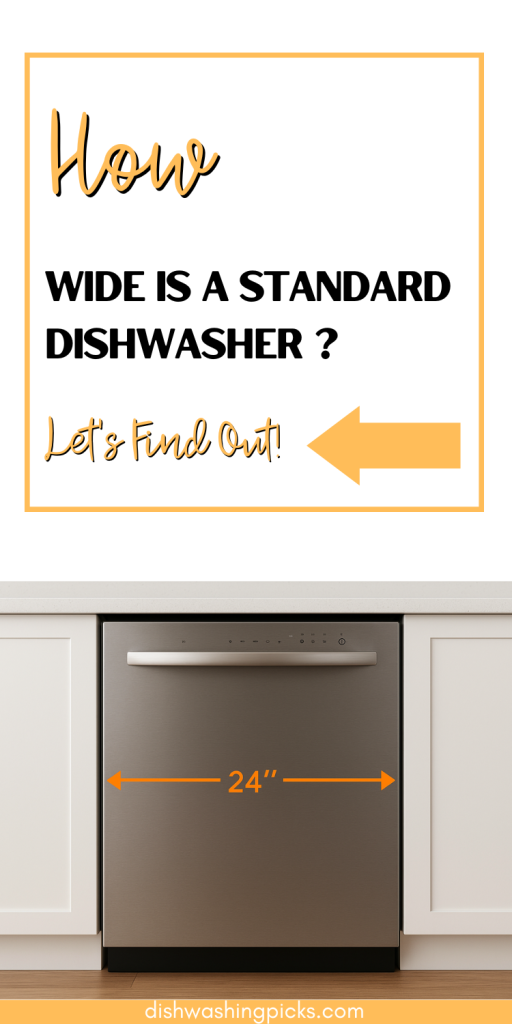
Wait… Do Dishwashers Even Come in Different Widths?
Ah, the dishwasher. That trusty kitchen sidekick that saves us from standing over the sink every night, elbow-deep in suds and spaghetti sauce.
So, you’re shopping for a new one (or maybe just curious), and now you’re staring at product specs like, “What do you mean 24 inches? Is that normal? Is mine 24 inches? Should it be?”
Don’t worry. You’re not the only one Googling this. Let’s get into it.
So, How Wide Is a Standard Dishwasher?
Drumroll, please…
👉 The standard width of a built-in dishwasher is 24 inches.
Like, 24 inches wide exactly. Not 24.5. Not 23.2. Just 24 inches.
That’s the size designed to fit perfectly into that cozy little slot under most countertops—usually between cabinets, right next to the sink. If your kitchen was built or remodeled in the last 30-ish years, chances are, it was made with that width in mind.
Think of it like jeans for your kitchen. 24 inches is the classic “straight fit” that just works with almost everything.
Are There Smaller Ones?
Yup! Not every kitchen’s rocking full-size real estate.
If you’re in a smaller space—like an apartment, RV, tiny home, or just rocking minimalist vibes—there’s a compact dishwasher size too.
👉 Compact dishwashers are typically 18 inches wide.
Still built-in, still automatic, still gets the job done. Just fewer plates per load. Ideal for 1–2 people, or anyone who just doesn’t go through 12 forks a day.
Fun fact: Some people also install these as a second dishwasher. Like a mini backup for glassware or bar stuff. Fancy, right?
What About Height and Depth?
Okay, so now that we’ve got width sorted—because that’s the big one—what about the other dimensions?
Height:
Most standard dishwashers are around 34 to 35 inches high, so they sit flush under the countertop.
Depth:
Usually around 24 inches deep, front to back. Enough to slide in nicely, door and all.
But here’s the thing: dishwashers need a bit of wiggle room. So when measuring your space, leave a little breathing room around it—especially behind the unit for the water hose and power hookup.
Do You Have to Get a 24-Inch Dishwasher?
Not necessarily! But here’s where it depends on you:
- Got the space? Go standard. You’ll get more capacity, more model options, and often better features.
- Tight squeeze? Go compact. You’ll save space without losing functionality.
- Replacing an old one? Measure before you buy. Like, actually measure. Width, depth, height. Don’t assume. Your cabinets might’ve been custom or hacked together by a past DIY-happy homeowner.
🎯 Hot tip: If you’re not sure, tape off 24″ on the floor with painter’s tape. It’ll give you a real-world visual of how much space it takes.
Measuring 101: Don’t Wing It
Here’s a quick way to check your space:
- Grab a tape measure.
- Measure the width of the space between cabinets (left to right).
- Check the height from the floor to the bottom of the countertop.
- Then measure the depth from the wall to the cabinet edge.
If your opening is around 24” wide, 34” high, and 24” deep—you’re golden for a standard model.
If it’s less? You’re shopping in compact territory.
If it’s way more? You either don’t have cabinets, or you might be planning a remodel (good luck and godspeed).
Final Thoughts: It’s Just a Measurement… But It Matters
So yeah, 24 inches. That’s the magic number.
But beyond that number is the real point: knowing your space, knowing what fits, and not finding out too late that your shiny new Bosch won’t actually slide in because the drawer next to it sticks out half an inch too far.
Measure. Plan. Then shop. That’s the move.
Because while dishwashers are supposed to make life easier… the wrong size one? Total nightmare. Trust me.
Need help finding a model that fits a weird cabinet layout? Want to turn this into a checklist or graphic for easy measuring? I got you. Let’s make sure your next dishwasher is the perfect fit—literally. 😄📏🧼
